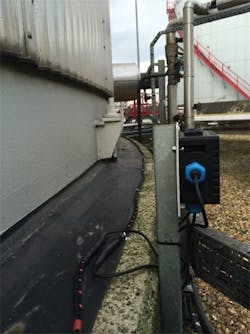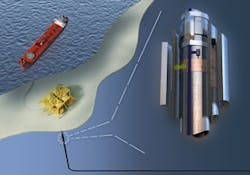Of course, there are always a few rules to obey and guidelines to follow. Even though it can deliver the same information as a hardwired system, wireless still has some unique design and operating requirements. However, making those adjustments is worthwhile because of all the advantages wireless can deliver.
Wider Circles, Bigger Umbrellas
For instance, 20-year-old system integrator Croft Automation in Waco, Texas, has a client running an oil well production field with a 20-mile radius, so it must closely monitor tank levels at many remote production sites, multiple compression sites and central delivery points, as well as comply with U.S. Environmental Protection Agency (EPA) regulations and prevent other problems. For example, if a high tank level occurred at the central delivery point, Croft's customer needs to shut down production automatically to avoid spills and minimize environmental impacts. The field, tanks and other facilities had an alarm system, but it wasn't reliable. Its original notification system also was too slow and sometimes failed to deliver messages.
To acquire more notifications more reliably, Croft selected Radioline wireless devices from Phoenix Contact, which extend the reach of I/O and serial communications to as many as 250 devices, easily sets up using a thumbwheel and I/O mapping instead of complex programming software, and can monitor via I/O-to-I/O, I/O-to-Modbus and serial-to-serial networking. Radioline is available in 2.4-GHz or 900-MHz frequency ranges, but Croft opted for 900 MHz, which can be used in long-range applications up to 20 miles and for short-range, non-line-of-sight installations. As for alarms, even if the user doesn't get a notification, Radioline can still help suspend production when required.
"Some of these sites can be nasty, hot and extremely dusty, but Radioline gives our customers field flexibility with Modbus and even more flexibility with wire replacement," says Johnny Jones, automated systems manager at Croft. "It was easy to set up one radio as the master and then communicate to multiple remote sites, while doing control from a single master. The low power draw was another distinct advantage for the remote sites, so engineers don't have to replace batteries very often."
See also: Occidental overcomes rough terrain by automating 200 wells with wireless
So far, Croft has installed Radioline in 83 locations at the production field, including master and field sites. Jones plans to add 20 to 30 more nodes within the next year and reports that Radioline also reduces maintenance visits, hours and costs. "This solution gives us a cleaner finished product that our customers are happier with," says Jones.
Justin Shade, wireless product marketing specialist at Phoenix Contact, adds that, "Wireless networking continues gain acceptance in industrial applications. With the cost of copper continuing to rise, and wireless manufacturers creating newer products that are reliable and easy to implement, the use of wireless devices is continually growing.
"Simplicity is always most important when implementing a wireless system. The biggest drivers of wireless are the ease of installation, reduced maintenance costs and the ability to quickly program the network. If it can't be installed correctly and quickly, then it's no longer a cost-effective alternate to running wire. To make adoption easy, wireless manufacturers are adding ways to easily install and program their devices. These include solutions as simple as external LEDs to show signal strength or configuring modules via thumbwheels, pushbuttons or SD cards. Being able to configure or maintain a module without using a computer allows installers to be quick and efficient."
Many Tight Spots
Ironically, besides spanning large areas, wireless is probably most useful and adept at handling small places and numerous locations where it's too cramped or costly to use hardwiring.
For example, BP's chemical production center in Geel, Belgium, needed a reliable, affordable way to gather data from its many hydrocarbon sensors that continuously monitor its tanks, valves and pipelines, and deliver it to the control system to notify operators of any leaks. Leak detection on large sites can be difficult and costly, and BP's operators were already making twice-daily inspection rounds using portable leak detectors, but new and stricter government regulations for storing and handling flammable liquids required continuous monitoring. However, a traditional, online monitoring solution would require extensive cabling, associated I/O, signal converters and installation costs.
As a result, BP integrated its hydrocarbon sensors with Smart Wireless components from Emerson Process Management, which enabled cost-effective leak detection, even from remote locations at the plant. Based on the IEC 62591 WirelessHART protocol, the new wireless devices were easier for BP's maintenance team to install because they didn't need new instrument cabling, trenches and ducting, which saved an estimated 50% on the material cost and 90% of the time needed to install a conventional hardwired system.
The plant's new leak detection system uses Emerson's Rosemount 702 wireless discrete transmitters in combination with Pentair's Fast Fuel sensors and TraceTek sensor cables. When one of the sensors detects xylene or benzene, their associated Rosemount 702 wirelessly transmits an alarm signal to a Smart Wireless gateway that relays it to the control room, where operators monitor and record the status for accurate incident reporting and time stamping in the host control system.
Figure 1: BP's chemical production center in Geel, Belgium, combines Emerson Process Management's Rosemount 702 wireless transmitters with Pentair's Fast Fuel sensors to detect xylene or benzene leaks in its tank walls, valves and pipelines.
Phto credit: Emerson and BP
"By combining Emerson's wireless technology with hydrocarbon sensors, BP has expanded its operators' view and enhanced its existing leak detection practices, and helped improve site safety,” says Bob Karschnia, Emerson's wireless vice president. "This is another example of how users are taking advantage of wireless to gain business benefits, including enhanced safety and regulatory compliance, in applications beyond the processes themselves."
Moazzam Shamsi, director of global solutions architects at Emerson, adds that, "Wireless is achieving a high level of confidence among design/plant engineers, and this confidence has resulted in wireless being increasingly deployed plantwide for multiple applications in brownfield and greenfield plants. In brownfield projects, the objective is to use wireless to deploy solutions to meet operational excellence initiatives through a pervasive plantwide deployment. In greenfield projects, the contractor and user see the technology as a mitigation strategy in the management of cost, schedule, space and weight by using wireless measurements in some instances instead of wireless.
Shamsi adds that standards such as WirelessHART are further aiding acceptance of wireless and even lessening the need for site assessments. "The most widely used protocol in the process industry is WirelessHART, and it has been ratified as an international standard for some years now as IEC 62591. Extensive features within the protocol help with coexistence management with other network,s thus optimizing bandwidth and radio time," explains Shamsi. "In addition, no site survey is required for sensor network technologies, such as WirlessHART. Using a simple rule set, this technology can be easily planned and implemented successfully. Wireless greenfield projects are being planned today with a few simple steps: Locate instruments based upon segmentation criteria, such as plant area per unit; check coverage via scaled site drawing; locate repeaters as required to increase network resilience; and verify network using a planning tool."
Experience and Ease
One dividend of so many wireless applications deploying in recent years is the experience and advice that veteran users can relay to their less-experienced counterparts, along with technical innovations that make wireless a lot easier to install and run.
For instance, Valero Energy Corp.'s refinery in Wilmington, California, processes California/foreign crude oil blend and unfinished feedstock from local and foreign sources, and it's undertaken several multiyear projects to adopt and update wireless across its facilities. The refinery's staff uses an ISA100-compliant OneWireless R200 mesh network from Honeywell Process Solutions, including its wireless device managers (WDMs), field device access points (FDAPs) and XYR6000 wireless transmitters.
The finished, active network consists of 30 wireless transmitters, 11 FDAPs, two FDAPs wired to the DCSs and WDMs connected via serial Modbus to the Honeywell DCS. These devices perform non-critical process monitoring of pipeline movement, flare monitoring, LPG purge gas pressure, heat exchanger temperature and tank high-level alarms, which enable operators to react quickly to changing conditions.
"The Wilmington refinery's site-wide industrial wireless infrastructure performs process measurements in areas of the plant where wiring is impractical or cost-prohibitive, and does it without interrupting normal operations," explains Rick Felix, associate process control systems coordinator at Valero. "Honeywell's OneWireless enables our operators to monitor a wide range of operations and process variables."
Valero reports that OneWireless helps optimize its plant processes and reliability, improve safety and security, ensure regulatory compliance, integrate valuable data into control systems and advanced applications, and share that information with other networked applications. Furthermore, reduced cost-per-I/O with wireless can help justify projects that aren't feasible with wired transmitters.
The Wilmington refinery upgraded to R200 in 2012 from a OneWireless R120 setup after dealing with signal strength issues due to antenna wrapping and cabling and difficulty programming multinodes. These were replaced by the FDAPs in the R200, which was less labor intensive and also improved system reliability and connectivity, provided an intuitive, web-based user interface and allowed integration of the wireless network with the DCS using industry-standard protocols.
In the infrastructure of OneWireless, the FDAP also assumes message-routing duties, so users can connect wireless devices to the control network and route data from the field. It also allows creation of an ISA100 wireless network of field instruments that communicate with each other and route messages from neighboring field devices to process control applications. Also, the WDM serves as a gateway and security manager to ensure that communication between field instruments and the plant network is secure. It supports a web-based user interface, allowing process and field instrument engineers with basic IT knowledge to quickly set up the wireless system. This approach reduces the time required to commission, monitor and troubleshoot the wireless device network.
In the future, Valero plans to install six universal I/O transmitters to operate gates at the Wilmington plant and use wireless for coke-drum, vent-valve monitoring. Also, the refinery will serve as a beta site for the OneWireless R220 release with redundant WDMs and redundant, fault-tolerant Ethernet (FTE) networking.
"Wireless is a lot less like missionary work now than it was five or six years ago when users needed constant reassurance. These days, people aren't scared anymore and are benefiting from wireless faster," says Diederik Mols, business leader for industrial wireless at Honeywell. "And even though ISA100 took two or three years longer to develop, its result is superior because it has a more advanced general client interface, and this allows any protocol to work with it. For example, Honeywell and Enraf's level gauges start out with proprietary communication protocols, but ISA100 enables both to communicate with wireless. This means a lot more freedom of choice for end users, such as deciding when to use sensors as repeaters when they don't need real-time performance, or when to have them do routing or not. As a result, we're seeing more vendors joining the ISA100 Wireless Compliance Institute and getting certified that their devices support ISA100."
Safety, Security Add-Ons
Beyond simplifying process control reducing cables and bringing in more signals, wireless grants users a bunch of other capabilities that many are beginning to explore and apply. In many cases, process control is being joined by video feeds, material handling, personnel and asset tracking, security and other functions.
For example, engineers at SAMREF's refinery complex in Yanbu, Saudi Arabia, wanted to use wireless to enhance their incident management procedures and rescue operations. This meant accessing video signals from closed-circuit TV (CCTV) cameras via the flexible access points in their OneWireless network, and using Honeywell Digital Video Manager (DVM) software to achieve remote coverage of the refinery and its often hard-to-reach operations from moving vehicles.
SAMREF is a joint venture between Saudi Aramco and Mobil Yanbu Refining Co., a subsidiary of Exxon Mobil Corp. It produces about 400,000 barrels per day, including gasoline, heating oil, LPG, jet fuel and other products. "Wireless seemed like the natural answer to our immediate need for mobile video monitoring," says Azam Al-Hakeem, IT superintendent at SAMREF.
To design and implement its video-via-wireless network, SAMREF and Honeywell conducted a comprehensive radio frequency (RF) site survey of its Yanbu export refinery to make sure any issues were identified and addressed before installation. Next, they implemented Cisco Aironet 1552S access points with integrated ISA100, a Cisco wireless LAN controller, a Honeywell DVM, wireless PTZ video camera mounted on the incident command vehicle and a Honeywell wireless, vehicle-mounted tablet PC.
Consequently, live streaming video over wireless lets SAMREF's staffers record safety and security incidents, compare them with previous incidents and keep a video record of near misses. It also gives the refinery's incident commander a direct view of real-time, streaming video from his vehicle so he can make faster decisions during crisis situations and reduce his dependence on the control room. Each wireless access point includes three radios: one for communicating with traditional transmitters, a second radio for communicating with Wi-Fi device, and a third radio for high-speed communicating of field data.
Similarly, Suncor Energy recently sought a wireless network that could help it improve physical security at its refinery in Commerce City, Colorado., which has 2,500 employees, produces close to 98,000 barrels per day, and has a communications network that centrally monitors more than 70 access keycard readers and more than 100 IP-based video security cameras (Figure 2). However, the new wireless network would have to overcome its location in the midst of Suncor's metal storage tank farm and also support mobile nodes and live video feeds from the plant's security vehicles.
Figure 2: Suncor's Commerce City refinery is using ABB's Tropos mesh networking and Honeywell's DVM software to centrally monitor more than 70 access keycard readers and more than 100 IP-based video security cameras.
Photo credit: James from Boulder and ABB
As a result, Suncor worked with ABB and Honeywell to design and install the new high-capacity, low-latency network so it could refresh and add video to its entry gate access controls and other plant locations. To aggregate both access control and video traffic, they selected Honeywell's DVM software to coordinate video feeds and ABB's Tropos wireless mesh and routers configured as gateways, which connect to fiber for backhaul and are powered by 24-Vdc power with battery backup. Some nodes use solar power to support Tropos and an IP camera. In the future, Suncor may add more fixed Tropos mesh nodes and a separate virtual local area network (VLAN) to further improve operations and speed access to information, such as using handheld wireless devices to take tank measurements and send them to a centralized database.
"There's so much more data coming in these days, especially from upstream oil and gas and unconventional production applications, but now users can simply move wired sensors to a Tropos wireless mesh and easily transfer data to collection points or local or centralized controls," says Chris Rittler, CEO of ABB Wireless, which grew from ABB's acquisition of Tropos about two and a half years ago. "Wireless really puts SCADA communications on steroids because, where we used to pull readings one to four time per hour, now we can track readings continuously and give more key people access to them."
Deep Places
For many process control engineers, deploying wireless has become second nature as it's proven its reliability and expanded its presence over the years. This success has paved the way for wireless deployments in some the world's most difficult and dangerous settings.
Figure 3: Statoil is using the Roxar Downhole Wireless PT Sensor System to measure temperature and pressure behind well casings, confirm pressure-barrier integrity and deliver early warnings about abnormal conditions on its subsea wells in Norway's North Sea.
Photo credit: Emerson and Statoil
The Roxar sensor system consists of an integrated downhole network (IDN) to carry signals from the wellbore to the user's monitoring system, a downhole network controller card (DHNC) placed in the subsea structure, and a wireless reader and PT transponder (Figure 3). Rated to operate at up to 225 °C, this system is attached to the same cable that can carry up to 32 other Emerson reservoir-monitoring gauges, so it becomes one more element of Emerson's integrated Roxar Permanent Downhole Monitoring System (PDMS).
Typically, deterioration of cement seals or loss of casing integrity due to increased pressure behind subsea well casings can allow injection or reservoir gas to migrate vertically along the outside of the casing, leading to unwanted and potentially hazardous conditions, such as uncontrolled gas escaping at the surface or, in the worst- case scenario, a shallow gas blow out due to failed barriers in the casing. By continuously monitoring and detecting pressure and temperature variations behind the casing during the life of a subsea well, the Roxar sensor system provides positive confirmation of the pressure barrier's integrity, allows operators to secure an early warning of any abnormal situations, and lets them quickly take remedial action, protect the well, and ensure offshore safety.
"Statoil took the initiative towards Emerson to develop technology for B-annulus monitoring on subsea wells," explains Hilde Brandanger Haga, well-integrity engineering leader at Statoil ASA. "Statoil was pleased with the successful installation and expected to have this Emerson equipment qualified as TRL7, Proven technology by early April 2014."
Likewise, Dundee Precious Metals' (DPM,) mine in Chelopech, Bulgaria, produces gold, copper and silver concentrate, but it began seeking a 30% production increase in 2010 by greatly increasing visibility into its underground operations. This required improved communications for tracking people and equipment, monitoring filled buckets, and measuring engine and oil temperatures to aid predictive repairs and reduce downtime. Former "leaky feeder" cables could send and receive radio signals, but they only allowed communication within the same tunnel.
Consequently, DPM's IT department worked with Cisco's Gold-Certified partner, Acrodex, and they implemented a Cisco Unified Wireless network, which consisted of installing 280 Cisco Aironet wireless access points to provide Wi-Fi and large-scale Internet protocol (IP) coverage along 50 kilometers of tunnels. Managed by a C240 rack server and Cisco Unified Communications Manager software, this network links everyone and many devices in the mine, including Cisco IP phones, in-vehicle tablet PCs, video cameras, Cisco Telepresence units, proprietary mining PLCs on the mill conveyor, lights, fans, power and the blasting system.
"The idea was to take the lid off the mine, so we could see exactly what was going on as it was happening, instead of waiting until shift change," says Mark Gelsomini, DPM's corporate IT director. "However, communications in mines is very challenging because Wi-Fi tradionally hasn't worked. We chose Cisco because they were willing to help us as we developed a custom, 2.4-GHz antenna to work underground."
Gelsomini reports that DPM's IP-based network makes all its processes more efficient. For example, operators, drivers, supervisors and manager can use the IP phones to communicate anywhere at the mine, above or below ground, and configure them to work like push-to-talk (PPT) devices. Using the wide area network (WAN) for voice and videoconferencing has saved nearly $2.5 million in long-distance charges over two years. The miners can also exchange instant messages using Cisco Jabber on their phones, smartphones, tablet PCs and PCs. They can also capture video to hasten equipment repairs; secure signals from RFID tags on miners and vehicles for better tracking and safety; and even transmit blast signal via wireless, which is safer because the blasting system is coordinated with the people-tracking system.
"It's one more precaution to make sure that blasting will not occur unless every individual has exited the mine. We also know where each vehicle is, so we can send an instant message to the driver to adjust the route to pick up more ore," says Gelsomini. "And instead of leaving our vehicles idle, we're redeploying them to get closer to 100% utilization." He adds that using Cisco Unified Wireless has allowed DPM to coordinate operations and improve processing from 0.5 million tons to 2 million tons per year, far exceeding its initial 30% goal.
"Many applications are now completely accepting of wireless. It's no longer an uphill battle," adds Sami Suheil, product manager for VMonitor, which was recently acquired by Rockwell Automation. "The ISA100 standard is clear on the path it's taking, which is providing superset coverage of all wireless applications including process. As a result, we're seeing wireless everywhere as it becomes mainstream."
Every process and environment has unique needs, but they all share some common basic requirements for implementing wireless. In both indoor and outdoor locations, these ingredients and procedures include:
- Add up and evaluate each site, facility and application's primary, functional and output demands to determine what wireless solution will serve them best.
- Examine present hardwired, point-to-point, fieldbuses and other network infrastructures and support software, and update communication integration policy.
- Seek management buy-in and recruit a team to draft a uniform wireless platform and jointly develop wireless policy and standards for all applicable sites. Standards should include wireless protocols, device communication speeds and data packet sizes, security procedures and other common specifications.
- Perform a radio frequency assessment and wireless site survey to decide on coverage for the application and the facility, and identify unique environmental characteristics, including potential locations of RF interference. Evaluate and choose appropriate antennas and support components, and determine best installation locations for secure signal transmission and reception.
- Start by installing wireless devices in a limited, non-essential, startup application to check on individual site issues and requirements. Be certain that wireless components can be readjusted and relocated, especially to accommodate future application and network growth.
- Teach operators, technicians and engineers the implementation, diagnostics and maintenance abilities needed to gain the most benefits from their wireless network.
- Complete regular reassessments and perform upgrades as needed.









